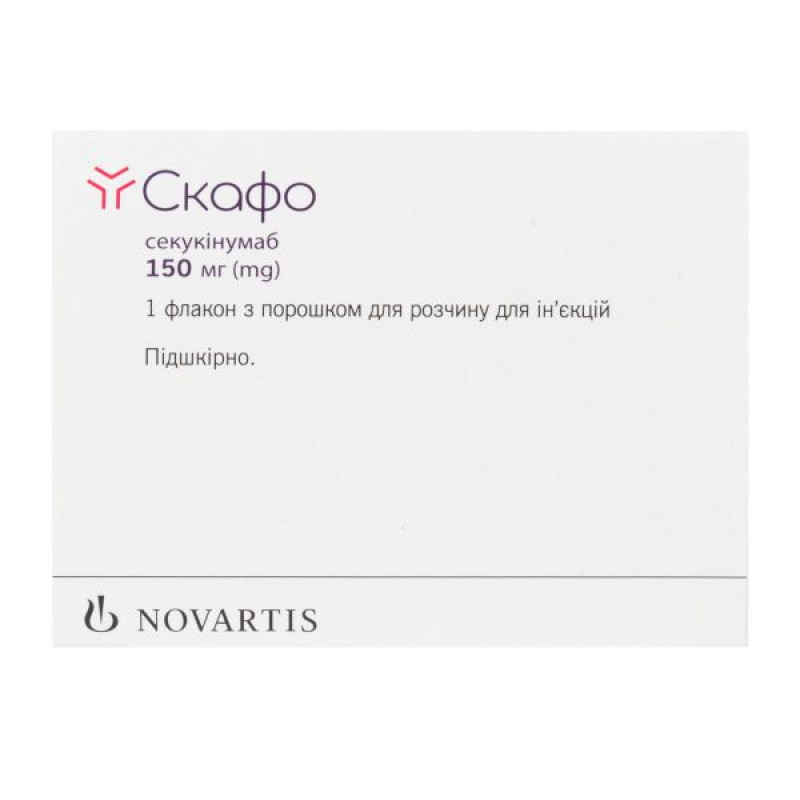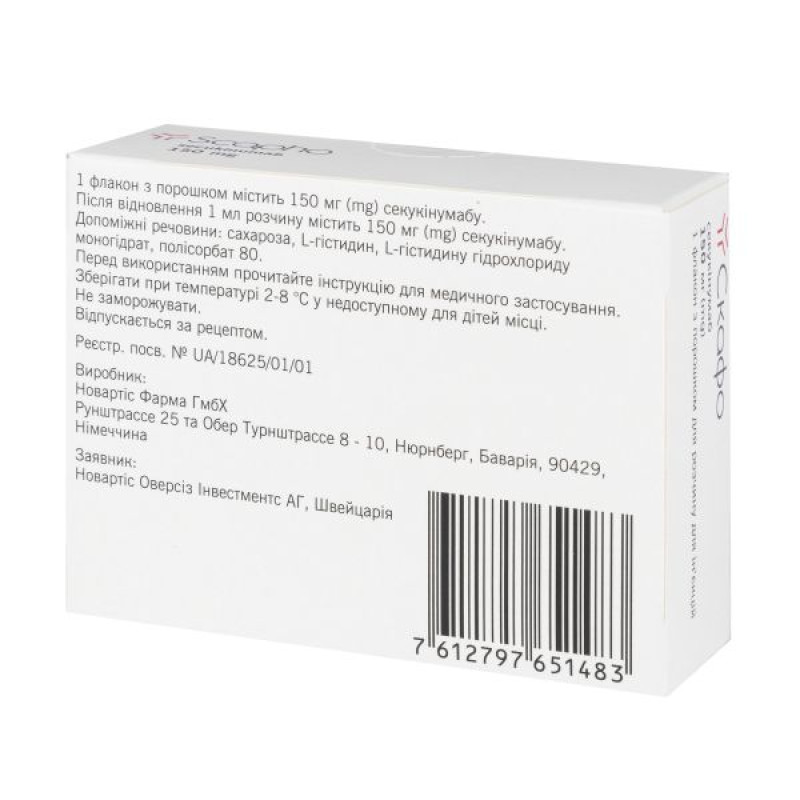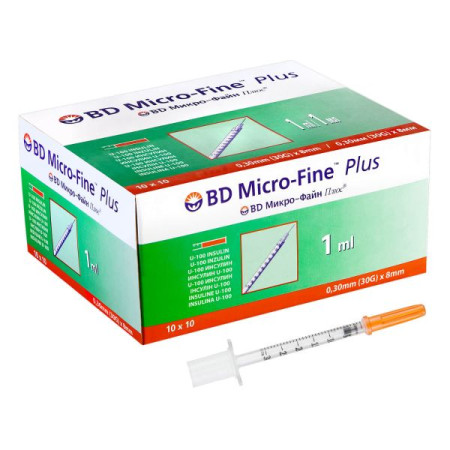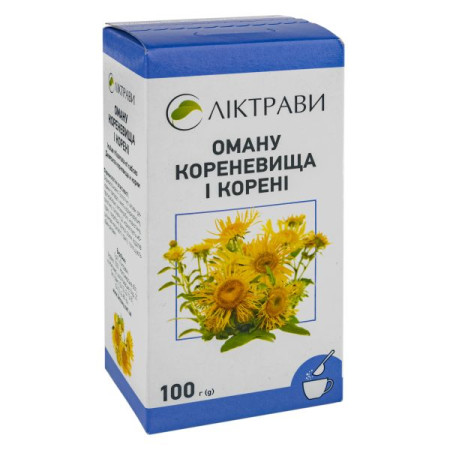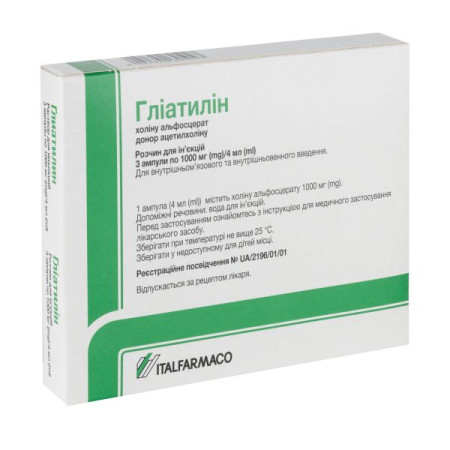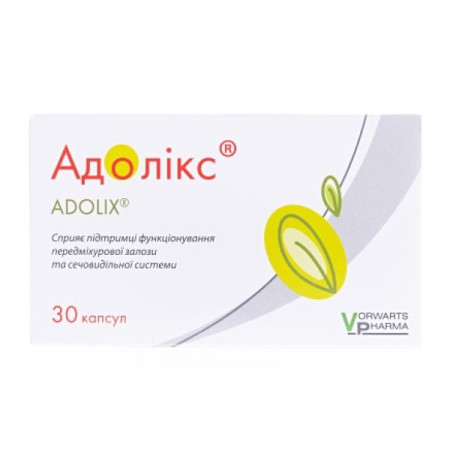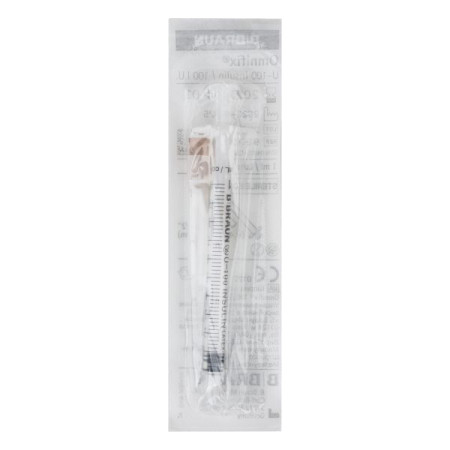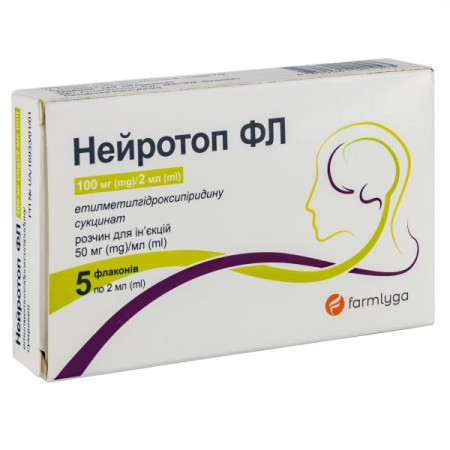Scafo powder for solution for injection 150mg No. 1
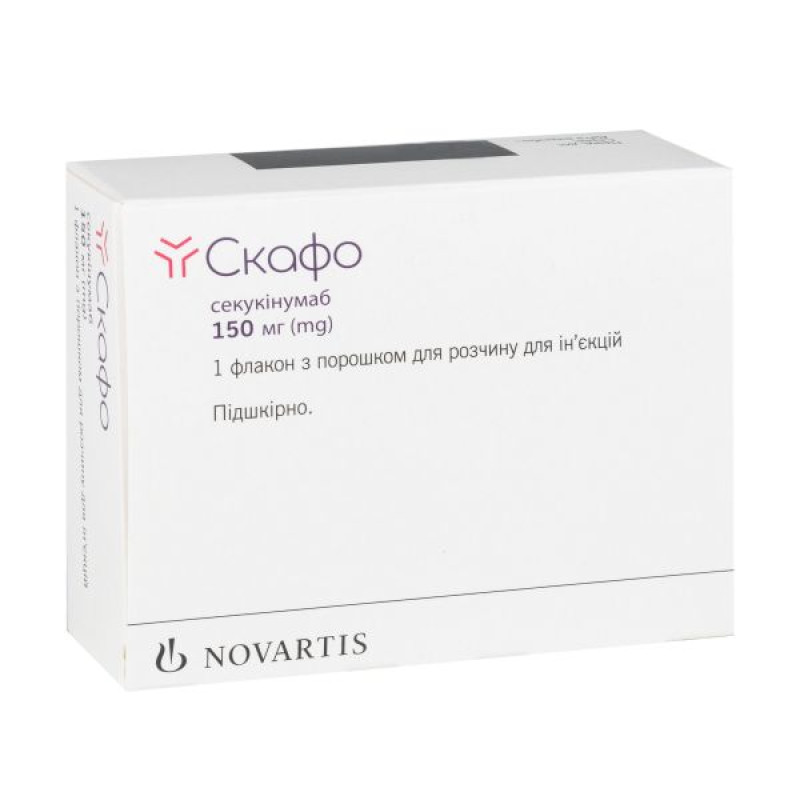
Instructions for use Scafo powder for solution for injection 150mg No. 1
Composition
active ingredient: secukinumab;
1 vial of powder contains 150 mg of secukinumab;
after reconstitution, 1 ml of solution contains 150 mg of secukinumab;
excipients: sucrose, L-histidine, L-histidine hydrochloride monohydrate, polysorbate 80.
Dosage form
Powder for solution for injection.
Main physicochemical properties: the powder is a solid white lyophilisate.
Pharmacotherapeutic group
Immunosuppressants, interleukin inhibitors.
ATX code L04A C10.
Pharmacological properties
Pharmacodynamics.
Mechanism of action
Secukinumab is a fully human IgG1/κ monoclonal antibody that selectively binds to and neutralizes the pro-inflammatory cytokine interleukin-17A (IL-17A). Secukinumab targets IL-17A and inhibits its interaction with the IL-17 receptor, which is expressed by various cell types, including keratinocytes. As a result, secukinumab slows the release of pro-inflammatory cytokines, chemokines, and mediators of tissue damage, reducing the contribution of IL-17A to autoimmune and inflammatory diseases. Secukinumab penetrates the skin at clinically relevant concentrations and reduces the concentration of inflammatory markers. A direct consequence of treatment with secukinumab is a decrease in the severity of redness, thickening, and scaling of the skin observed in plaque psoriasis lesions.
IL-17A is a naturally occurring cytokine involved in the natural inflammatory and immune responses. IL-17A plays a key role in the pathogenesis of plaque psoriasis, psoriatic arthritis, and axial spondyloarthritis (ankylosing spondylitis and non-radiographic axial spondyloarthritis) and is upregulated in affected skin compared to unaffected skin of patients with plaque psoriasis, as well as in the synovial tissue of patients with psoriatic arthritis. In patients with ankylosing spondylitis, a significant increase in the number of IL-17A-producing cells is observed in the subchondral bone marrow of the facet joints. Increased IL-17A concentrations have also been found in the blood of patients with non-radiographic axial spondyloarthritis. It has been shown that inhibition of
IL-17A is effective in the treatment of ankylosing spondylitis, thus establishing a key role for this cytokine in axial spondyloarthritis.
Pharmacodynamic effects
Serum levels of total IL-17A (free and secukinumab-bound IL-17A) were initially increased in patients treated with secukinumab. This was due to a decrease in the clearance of secukinumab-bound IL-17A, indicating that secukinumab selectively binds to free IL-17A, playing a key role in the pathogenesis of plaque psoriasis.
In a study in patients with plaque psoriasis, after one to two weeks of treatment with secukinumab, epidermal infiltration by neutrophils and the number of various markers associated with them, which are often elevated in the affected areas of the skin in such patients, were significantly reduced.
Secukinumab has been shown to reduce (within 1–2 weeks of treatment) levels of C-reactive protein, which is a marker of inflammation.
Clinical efficacy and safety
Plaque psoriasis in adults
The safety and efficacy of secukinumab were evaluated in four randomized, double-blind, placebo-controlled phase III studies in patients with moderate to severe plaque psoriasis who were eligible for phototherapy or systemic therapy (ERASURE, FIXTURE, FEATURE, JUNCTURE).
The efficacy and safety of secukinumab 150 mg and 300 mg were evaluated compared with placebo or etanercept. In addition, one study evaluated a long-term regimen compared with an on-demand regimen (SCULPTURE).
Of the 2403 patients enrolled in placebo-controlled trials, 79% were biologic-naive, 45% were non-responders to non-biologics, and 8% were biologic-naive (6% were anti-TNF and 2% were anti-p40). In phase III trials, approximately
15–25% of patients had psoriatic arthritis (PA) at baseline.
Psoriasis study 3 (FEATURE) evaluated 177 patients using secukinumab pre-filled syringe compared to placebo 12 weeks after the start of treatment to assess the safety, tolerability and benefit of self-administration of secukinumab pre-filled syringe. Psoriasis study 4 (JUNCTURE) evaluated 182 patients using secukinumab pre-filled pen compared to placebo 12 weeks after the start of treatment to assess the safety, tolerability and benefit of self-administration of secukinumab pre-filled pen. In both studies (3 and 4), patients were randomised to receive secukinumab at doses of 150 mg or 300 mg at weeks 0, 1, 2 and 3 followed by monthly administration of the same dose starting at week 4. Patients were also randomized to placebo at weeks 0, 1, 2, and 3, followed by monthly administration of the same dose starting at week 4.
In psoriasis study 5 (SCULPTURE), 966 patients were evaluated. All patients received secukinumab at doses of 150 mg or 300 mg at weeks 0, 1, 2, 3, 4, 8, and 12 and were then randomised to receive monthly maintenance dosing starting at week 12 or to receive on-demand treatment at the same dose. Patients randomised to on-demand treatment did not achieve a satisfactory response to treatment and therefore monthly maintenance therapy at fixed doses is recommended.
The primary endpoints in the placebo-controlled and active-controlled studies were the percentage of patients achieving PASI 75 and IGA mod 2011 “clear” or “almost clear” compared to placebo at week 12 (see Tables 1 and 2). The 300 mg dose increased skin clearance to nearly clear or “almost clear” for the efficacy endpoints PASI 90, PASI 100, and IGA mod 2011 with a score of 0 or 1 in all studies, peaking at week 16, and is therefore the recommended dose.
Table 1
A brief overview of PASI 50/75/90/100 and IGA⃰ mod 2011 “clear” or “almost clear”
clinical response in psoriasis studies 1, 3 and 4 (ERASURE, FEATURE and JUNCTURE)
| Indicators | Week 12 | Week 16 | Week 52 | ||||||
| placebo | secukinumab | secukinumab | secukinumab | ||||||
| 150 mg | 300 mg | 150 mg | 300 mg | 150 mg | 300 mg | ||||
| Study 1 | |||||||||
| Number of patients | 246 | 244 | 245 | 244 | 245 | 244 | 245 | ||
| PASI 50 response, n (%) | 22 (8.9%) | 203(83.5%) | 222(90.6%) | 212(87.2%) | 224(91.4%) | 187(77%) | 207(84.5%) | ||
| PASI 75 response, n (%) | 11 (4.5%) | 174(71.6%)** | 200(81.6%)** | 188(77.4%) | 211(86.1%) | 146(60.1%) | 182(74.3%) | ||
| PASI 90 response, n (%) | 3 (1.2%) | 95 (39.1%)** | 145(59.2%)** | 130(53.5%) | 171(69.8%) | 88(36.2%) | 147(60.0%) | ||
| PASI 100 response, n (%) | 2 (0.8%) | 31(12.8%) | 70(28.6%) | 51(21.0%) | 102(41.6%) | 49(20.2%) | 96(39.2%) | ||
| IGA mod 2011 response “clear” or “almost clear”, n (%) | 6 (2.40%) | 125(51.2%)** | 160(65.3%)** | 142(58.2%) | 180(73.5%) | 101(41.4%) | 148(60.4%) | ||
| Study 3 | |||||||||
| Number of patients | 59 | 59 | 58 | - | - | - | - | ||
| PASI 50 response, n (%) | 3 (5.1%) | 51 (86.4%) | 51(87.9%) | - | - | - | - | ||
| PASI 75 response, n (%) | 0 (0.0 %) | 41 (69.5%)** | 44(75.9%)** | - | - | - | - | ||
| PASI 90 response, n (%) | 0 (0.0 %) | 27(45.8%) | 35(60.3%) | - | - | - | - | ||
| PASI 100 response, n (%) | 0 (0.0 %) | 5(8.5%) | 25(43.1%) | - | - | - | - | ||
| IGA mod 2011 response “clear” or “almost clear”, n (%) | 0 (0.0 %) | 31 (52.5%)** | 40(69.0%)** | - | - | - | - | ||
| Study 4 | |||||||||
| Number of patients | 61 | 60 | 60 | - | - | - | - | ||
| PASI 50 response, n (%) | 5 (8.2%) | 48(80.0%) | 58(96.7%) | - | - | - | - | ||
| PASI 75 response, n (%) | 2 (3.3%) | 43(71.7%)** | 52(86.7%)** | - | - | - | - | ||
| PASI 90 response, n (%) | 0 (0.0 %) | 24(40.0%) | 33(55.0%) | - | - | - | - | ||
| PASI 100 response, n (%) | 0 (0.0 %) | 10(16.7%) | 16(26.7%) | - | - | - | - | ||
| IGA mod 2011 response “clear” or “almost clear”, n (%) | 0 (0.0 %) | 32 (53.3%)** | 44(73.3%)** | - | - | - | - | ||
*IGA mod 2011 is a 5-point scale, including indices 0 – “clear”, 1 – “almost clear”, 2 – “mild”, 3 – “moderate” or 4 – “severe”, which indicates the overall physician assessment of the severity of psoriasis in terms of induration, erythema and scaling. The treatment effect, defined as “clear” or “almost clear”, is the absence of signs of psoriasis or lesions of natural or pink color, the absence of plaque thickening, and the absence or minimal local scaling of the skin.
**P-values versus placebo and adjusted for multiplicity: p < 0.0001.
Summary of clinical response in psoriasis study 2 (FIXTURE)
| Indicators | Week 12 | Week 16 | Week 52 | |||||||
|---|---|---|---|---|---|---|---|---|---|---|
| placebo | secukinumab | etanercept | secukinumab | etanercept | secukinumab | etanercept | ||||
| 150 mg | 300 mg | 150 mg | 300 mg | 150 mg | 300 mg | |||||
| Number of patients | 324 | 327 | 323 | 323 | 327 | 323 | 323 | 327 | 323 | 323 |
| PASI 50 response, n (%) | 49(15.1%) | 266(81.3%) | 296(91.6%) | 226(70.0%) | 290 (88.7%) | 302 (93.5%) | 257(79.6%) | 249(76.1%) | 274 (84.8%) | 234(72.4%) |
| PASI 75 response, n (%) | 16(4.9%) | 219(67.0%)** | 249(77.1%)** | 142(44.0%) | 247 (75.5%) | 280 (86.7%) | 189(58.5%) | 215 (65.7%) | 254 (78.6%) | 179(55.4%) |
| PASI 90 response, n (%) | 5(1.5%) | 137(41.9%) | 175(54.2%) | 67(20.7%) | 176 (53.8%) | 234 (72.4%) | 101(31.3%) | 147 (45.0%) | 210 (65.0%) | 108(33.4%) |
| PASI 100 response, n (%) | 0 (0 %) | 47(14.4%) | 78(24.1%) | 14(4.3%) | 84(25.7%) | 119 (36.8%) | 24(7.4%) | 65(19.9%) | 117 (36.2%) | 32(9.9%) |
| IGA mod 2011 response “clear” or “almost clear”, n (%) | 9(2.8%) | 167 (51.1%)** | 202(62.5%)** | 88(27.2%) | 200 (61.2%) | 244 (75.5%) | 127(39.3%) | 168 (51.4%) | 219 (67.8%) | 120(37.2%) |
**p value versus etanercept: p = 0.0250.
In an additional psoriasis study (CLEAR), 676 patients were evaluated. Secukinumab 300 mg met the primary and secondary endpoints, demonstrating greater efficacy than ustekinumab based on PASI 90 response at week 16 (primary endpoint), speed of onset of PASI 75 response at week 4, and sustained PASI 90 response at week 52. Superior efficacy compared to ustekinumab for PASI 75/90/100 and IGA mod 2011 index scores of 0 or 1 (“clear” or “almost clear”) was observed at baseline and continued through week 52.
Table 3
Summary of clinical response in the CLEAR study
| Indicators | Week 4 | Week 16 | Week 52 | |||
|---|---|---|---|---|---|---|
| Secukinumab 300 mg | Ustekinumab* | Secukinumab 300 mg | Ustekinumab* | Secukinumab 300 mg | Ustekinumab* | |
| Number of patients | 334 | 335 | 334 | 335 | 334 | 335 |
| PASI 75 response, n (%) | 166(49.7%)** | 69(20.6%) | 311(93.1%) | 276(82.4%) | 306(91.6%) | 262(78.2%) |
| PASI 90 response, n (%) | 70(21.0%) | 18(5.4%) | 264(79.0%)** | 192(57.3%) | 250(74.9%)*** | 203(60.6%) |
| PASI 100 response, n (%) | 14(4.2%) | 3(0.9%) | 148(44.3%) | 95(28.4%) | 150(44.9%) | 123(36.7%) |
| IGA mod 2011 response “clear” or “almost clear”, n (%) | 128(38.3%) | 41(12.2%) | 278(83.2%) | 226(67.5%) | 261(78.1%) | 213(63.6%) |
*Patients receiving secukinumab received a dose of 300 mg at weeks 0, 1, 2, 3, followed by monthly administration of the same dose starting at week 4 through week 52. Patients receiving ustekinumab received 45 mg or 90 mg at weeks 0 and 4, then every 12 weeks through week 52 (weight-based dosing according to the approved dose).
**p value vs. ustekinumab: p < 0.0001 for the primary endpoint PASI 90 at week 16 and the secondary endpoint PASI 75 at week 4.
***p value vs. ustekinumab: p = 0.0001 for the secondary endpoint PASI 90 at
52nd week.
Secukinumab demonstrated efficacy in patients who were previously naïve to systemic therapy and biologic therapy, in patients who were previously treated with biologic/anti-TNF therapy, and in patients with an inadequate response to biologic/anti-TNF therapy. Improvement in PASI 75 score in patients with concomitant psoriatic arthritis at baseline was similar to that in the overall plaque psoriasis population.
Secukinumab 300 mg was associated with a rapid onset of efficacy with a 50% reduction in mean PASI score at 3 weeks.
|
|
Fig. 1. Changes over time in % from baseline in mean PASI score during Study 1 (ERASURE).
Two additional placebo-controlled studies demonstrated improvement in nail psoriasis (TRANSFIGURE, 198 patients) and palmoplantar plaque psoriasis (GESTURE, 205 patients). In TRANSFIGURE, secukinumab was superior to placebo at week 16 (46.1% in the 300 mg group, 38.4% in the 150 mg group, and 11.7% in the placebo group) in terms of significant improvement from baseline in the Nail Psoriatic Severity Index (NAPSI%) in patients with moderate to severe plaque psoriasis with nail involvement. In the GESTURE study, secukinumab was more effective than placebo at week 16 (33.3% in the 300 mg group, 22.1% in the 150 mg group, and 1.5% in the placebo group) in terms of significant improvement in ppIGA scores of 0 or 1 (“clear” or “almost clear”) in patients with moderate to severe palmoplantar plaque psoriasis.
A placebo-controlled study evaluated 102 patients with moderate to severe scalp psoriasis with a Psoriasis Scalp Severity Index (PSSI) ≥ 12, an IGA mod 2011 scalp index of 3 or greater, and at least 30% of the total scalp area affected. Secukinumab 300 mg was more effective than placebo on
At week 12, in terms of significant improvement from baseline in PSSI 90 (52.9% vs. 2.0%) and IGA mod 2011 scalp score 0 or 1 (56.9% vs. 5.9%). Improvements in each endpoint were maintained in patients who continued to receive secukinumab through week 24.
Quality of life/patient-reported outcomes
Statistically significant improvements from baseline at week 12 (studies 1–4) compared to placebo were demonstrated in the DLQI (Dermatology Life Quality Index). Mean decreases (improvements) from baseline in the DLQI ranged from -10.4 to -11.6 in patients receiving secukinumab 300 mg, from -7.7 to -10.1 in patients receiving secukinumab 150 mg, versus -1.1 to -1.9 in patients receiving placebo at week 12. These improvements were maintained through 52 weeks (studies 1 and 2).
Forty percent of participants in Studies 1 and 2 completed the Psoriasis Symptom Diary©. Participants who completed the diary in each of these studies showed statistically significant improvements from baseline at Week 12 compared to placebo in the signs and symptoms of itching, pain, and scaling.
Statistically significant improvements from baseline at week 4 in patients receiving secukinumab compared to patients receiving ustekinumab (CLEAR) were demonstrated in the DLQI, and these improvements were maintained through 52 weeks.
Statistically significant improvements in patients with signs and symptoms of scalp itching, pain, and scaling (CLEAR) at weeks 16 and 52 were demonstrated in the Psoriasis Symptom Diary© in patients treated with secukinumab compared to patients treated with ustekinumab.
In the scalp psoriasis study, statistically significant improvements (reductions) were demonstrated at week 12 from baseline in patients with signs and symptoms of scalp itching, pain, and scaling compared to placebo.
Psoriatic arthritis
The safety and efficacy of secukinumab were evaluated in 1999 patients in three randomised, double-blind, placebo-controlled phase III studies in patients with active psoriatic arthritis (≥ 3 swollen joints and ≥ 3 tender joints) despite treatment with non-steroidal anti-inflammatory drugs (NSAIDs), corticosteroids or disease-modifying anti-rheumatic drugs. These studies included patients with each subtype of psoriatic arthritis, including polyarticular arthritis without rheumatoid nodules, spondylitis with peripheral arthritis, asymmetric peripheral arthritis, distal interphalangeal joint involvement and arthritis mutilans. Patients had a history of psoriatic arthritis for at least five years at the time of the studies. The majority of patients also had active psoriasis with skin involvement or a documented history of psoriasis. More than 61% and 42% of patients with psoriatic arthritis had enthesitis and dactylitis, respectively, at baseline. For all studies, the primary endpoint was response according to ACR criteria 20. For Psoriatic Arthritis Study 1 and Psoriatic Arthritis Study 2, the primary endpoint was met at week 24. For Psoriatic Arthritis Study 3, the primary endpoint was met at week 16, along with the key secondary endpoint, change from baseline in modified TSS at week 24.
In the Psoriatic Arthritis Study 1 (FUTURE 1), 606 patients were evaluated, of whom 60.7% were receiving concomitant methotrexate. Patients randomized to secukinumab received 10 mg/kg intravenously at weeks 0, 2, and 4, followed by 75 mg or 150 mg subcutaneously monthly starting at week 8. Patients randomized to placebo who did not respond to treatment at week 16 (rescue agent) and other patients in the placebo group were crossed over to secukinumab (75 mg or 150 mg subcutaneously) at week 24, followed by monthly administration of the same dose.
The Psoriatic Arthritis Study 2 (FUTURE 2) evaluated 397 patients, of whom 46.6% were receiving concomitant methotrexate. Patients randomized to secukinumab received 75 mg, 150 mg, or 300 mg subcutaneously at weeks 0, 1, 2, and 3, followed by monthly dosing at the same dose starting at week 4. Patients randomized to placebo who did not respond to treatment at week 16 (early responders) were switched to secukinumab (150 mg or 300 mg subcutaneously) at week 16, followed by monthly dosing at the same dose. Patients randomized to placebo who responded to treatment at week 16 were switched to secukinumab (150 mg or 300 mg subcutaneously) at week 24, followed by monthly administration of the same dose.
In the psoriatic arthritis study 3 (FUTURE 5), 996 patients were evaluated, of whom 50.1% were receiving concomitant methotrexate. Patients were randomized to receive either secukinumab 150 mg, 300 mg, or placebo subcutaneously at weeks 0, 1, 2, 3, followed by monthly injections of the same dose starting at week 4, or monthly injections of secukinumab 150 mg (without loading). Patients randomized to placebo who did not respond to treatment at week 16 (early responders) were crossed over to secukinumab (150 mg or 300 mg subcutaneously) at week 16, followed by monthly injections of the same dose. Patients randomized to placebo who responded to treatment at week 16 were switched to secukinumab (150 mg or 300 mg subcutaneously) at week 24, followed by monthly administration of the same dose.
Signs and symptoms
Treatment with secukinumab resulted in significant improvements in disease activity scores compared with placebo at weeks 16 and 24 (see Table 4).
Table 4
Clinical response in Psoriatic Arthritis Study 2 and Psoriatic Arthritis Study 3 at weeks 16 and 24
| Indicators | Psoriatic Arthritis Study 2 | Psoriatic Arthritis Study 3 | ||||
| Placebo | 150 mg1 | 300 mg1 | Placebo | 150 mg1 | 300 mg1 | |
| Number of patients randomized | 98 | 100 | 100 | 332 | 220 | 222 |
| ACR 20 response, n (%) | ||||||
| Week 16 | 18(18.4%) | 60(60.0%***) | 57(57.0%***) | 91◊(27.4%) | 122◊(55.5%***) | 139◊(62.6%***) |
| Week 24 | 15◊(15.3%) | 51◊(51.0%***) | 54◊(54.0%***) | 78(23.5%) | 117(53.2%***) | 141(63.5%***) |
| ACR 50 response, n (%) | ||||||
| Week 16 | 6(6.1%) | 37(37.0%***) | 35(35.0%***) | 27(8.1%) | 79(35.9%*) | 88(39.6%*) |
| Week 24 | 7(7.1%) | 35(35.0%) | 35(35.0%**) | 29(8.7%) | 86(39.1%***) | 97(43.7%***) |
| ACR 70 response, n (%) | ||||||
| Week 16 | 2(2.0%) | 17(17.0%**) | 15(15.0%**) | 14(4.2%) | 40(18.2%***) | 45(20.3%***) |
| Week 24 | 1(1.0%) | 21(21.0%**) | 20(20.0%**) | 13(3.9%) | 53(24.1%***) | 57(25.7%***) |
| DAS28‑CRP | ||||||
| Week 16 | -0.50 | -1.45*** | -1.51*** | -0.63 | -1.29* | -1.49* |
| Week 24 | -0.96 | -1.58** | -1.61** | -0.84 | -1.57*** | -1.68*** |
| Number of patients with ≥ 3% skin psoriasis from PPT at baseline | 43(43.9%) | 58(58.0%) | 41(41.0%) | 162(48.8%) | 125(56.8%) | 110(49.5%) |
| PASI 75 response, n (%) | ||||||
| Week 16 | 3(7.0%) | 33(56.9%***) | 27(65.9%***) | 20(12.3%) | 75(60.0%*) | 77(70.0%*) |
| Week 24 | 7(16.3%) | 28(48.3%**) | 26(63.4%***) | 29(17.9%) | 80(64.0%***) | 78(70.9%***) |
| PASI 90 response, n (%) | ||||||
| Week 16 | 3(7.0%) | 22(37.9%***) | 18(43.9%***) | 15(9.3%) | 46(36.8%*) | 59(53.6%*) |
| Week 24 | 4(9.3%) | 19(32.8%**) | 20(48.8%***) | 19(11.7%) | 51(40.8%***) | 60(54.5%***) |
| Dactylitis development, n (%) † | ||||||
| Week 16 | 10(37%) | 21(65.6%*) | 26(56.5%) | 40(32.3%) | 46(57.5%*) | 54(65.9%*) |
| Week 24 | 4(14.8%) | 16(50.0%**) | 26(56.5%**) | 42(33.9%) | 51(63.8%***) | 52(63.4%***) |
| Enthesitis resolution, n (%) ‡ | ||||||
| Week 16 | 17(26.2%) | 32(50.0%**) | 32(57.1%***) | 68(35.4%) | 77(54.6%*) | 78(55.7%*) |
| Week 24 | 14(21.5%) | 27(42.2%*) | 27(48.2%**) | 66(34.4%) | 77(54.6%***) | 86(61.4%***) |
*p < 0.05, **p < 0.01, ***p < 0.001 versus placebo.
All p-values are adjusted for multiplicity of trials based on the pre-specified hierarchy at week 16 for psoriatic arthritis study 3, except for ACR 70, which was an exploratory endpoint, and all endpoints at week 24.
For a missing binary endpoint, the data imputation method is used in the absence of a response.
ACR – American College of Rheumatology; PASI – psoriasis area and severity index; DAS – disease activity index; BSA – body surface area.
Primary endpoint.
1 Secukinumab 150 mg or 300 mg subcutaneously at weeks 0, 1, 2, 3 followed by monthly administration of the same dose starting at week 4.
†In patients with dactylitis at baseline (n=27, 32, 46, respectively for Psoriatic Arthritis Study 2 and n=124, 80, 82, respectively for Psoriatic Arthritis Study 3).
‡In patients with enthesitis at baseline (n=65, 64, 56, respectively for Psoriatic Arthritis Study 2 and n=192, 141, 140, respectively for Psoriatic Arthritis Study 3).
The onset of action of secukinumab is observed as early as week 2. A statistically significant difference in ACR 20 between the secukinumab and placebo groups is achieved by week 3.
The number of patients who achieved an ACR 20 response by visit is shown in Fig. 2.
|
|
|
|
Fig. 2. ACR 20 response in Psoriatic Arthritis Study 2 over time to week 52.
Similar responses for the primary and key secondary endpoints were observed in patients with psoriatic arthritis regardless of concomitant methotrexate use. In psoriatic arthritis study 2, patients in the secukinumab plus methotrexate combination group had a higher ACR 20 response (47.7% and 54.4% of patients in the 150 mg and 300 mg groups, respectively, compared with 20.0% in the placebo group) and ACR 50 response (31.8% and 38.6% of patients in the 150 mg and 300 mg groups, respectively, compared with 8.0% in the placebo group) at week 24. Patients in the secukinumab group without concomitant methotrexate had a higher ACR 20 response (53.6% and 53.6% of patients in the 150 mg and 300 mg dose groups compared with 10.4% in the placebo group) and ACR 50 response (37.5% and 32.1% of patients in the 150 mg and 300 mg dose groups compared with 6.3% in the placebo group).
In psoriatic arthritis study 2, both TNFα-naive and TNFα-inadequate responders receiving secukinumab had a higher ACR 20 response compared to placebo at week 24, with a slightly higher response in the TNFα-naïve group (TNFα-naive: 64% and 58% in the 150 mg and 300 mg groups vs. 15.9% in the placebo group; TNFα-inadequate responders: 30% and 46% in the 150 mg and 300 mg groups vs. 14.3% in the placebo group). In the subgroup of patients with an inadequate response to anti-TNFα therapy, only the 300 mg dose demonstrated a significantly higher ACR 20 response rate compared to placebo (p < 0.05) and clinically meaningful benefits over the 150 mg dose on several secondary endpoints. Improvements in PASI 75 were observed in both subgroups, and the 300 mg dose demonstrated statistically significant benefits in patients with an inadequate response to anti-TNFα therapy.
The number of patients with psoriatic arthritis with axial skeletal involvement was very small, which does not allow for a valid assessment.
Improvements were observed in all ACR measures, including patient-reported pain. In psoriatic arthritis study 2, the proportion of patients who achieved a response according to the modified PsARC criteria was higher in the secukinumab group (59.0% and 61.0% in the 150 mg and 300 mg groups) than in the placebo group (26.5%) at week 24.
In psoriatic arthritis study 1 and psoriatic arthritis study 2, efficacy was maintained through week 104. In psoriatic arthritis study 2, of the 200 patients initially randomised to secukinumab 150 mg and 300 mg, 178 (89%) were still receiving treatment at week 52. Of the 100 patients randomised to secukinumab 150 mg, 64, 39 and 20 achieved an ACR 20/50/70 response, respectively. Of the 100 patients randomised to secukinumab 300 mg, 64, 44 and 24 achieved an ACR 20/50/70 response, respectively.
In psoriatic arthritis study 3, inhibition of progression of structural damage was assessed radiographically and was defined as the modified Sharpe score (mTSS) and its components, erosions and joint space narrowing. Radiographic images of the hands, wrists and feet were obtained at baseline, week 16 and/or week 24 and were assessed independently by at least two reviewers who were blinded to treatment group and visit number. Secukinumab 150 mg and 300 mg significantly inhibited the rate of progression of peripheral joint damage compared with placebo, as measured by the change from baseline in mTSS at week 24 (Table 5).
Inhibition of progression of structural damage was also assessed in Psoriatic Arthritis Study 1 at weeks 24 and 52 relative to baseline. Data at week 24 are presented in Table 5.
Table 5
Changes in the modified Sharpe score in psoriatic arthritis
| Indicators | Psoriatic Arthritis Study 3 | Psoriatic Arthritis Study 1 | |||
| placebon = 296 | secukinumab 150 mg1n = 213 | secukinumab 300 mg1n = 217 | placebon = 179 | secukinumab 150 mg2 N = 185 | |
| Total points | |||||
| Output level(SD) | 15.0(38.2) | 13.5(25.6) | 12.9(23.8) | 28.4(63.5) | 22.3(48.0) |
| Average change at week 24 | 0.50 | 0.13* | 0.02* | 0.57 | 0.13* |
*p < 0.05 based on nominal but unadjusted p-value.
1Secukinumab 150 mg or 300 mg subcutaneously at weeks 0, 1, 2, 3 followed by monthly administration of the same dose starting at week 4.
210 mg/kg at 0, 2 weeks followed by a subcutaneous dose of 75 mg or 150 mg starting at week 4.
In psoriatic arthritis study 1, suppression of structural damage was maintained through week 52 with secukinumab.
In psoriatic arthritis study 3, the proportion of patients with no disease progression (defined as a change from baseline in mTSS ≤ 0.5) from randomisation to week 24 was 80.3%, 88.5% and 73.6% in the secukinumab 150 mg, 300 mg and placebo groups, respectively. The effect of structural damage inhibition was observed in patients who were naïve to anti-TNFα therapy and in patients who had an inadequate response to anti-TNFα therapy, and in patients who were concomitantly treated with or without methotrexate.
In psoriatic arthritis study 1, the proportion of patients with no disease progression (defined as a change from baseline in mTSS ≤ 0.5) from randomisation to week 24 was 82.3% in the secukinumab 10 mg/kg intravenously followed by 150 mg subcutaneously as a maintenance dose and 75.7% in the placebo group. The proportion of patients with no disease progression from week 24 to week 52 in the secukinumab 10 mg/kg intravenously followed by 150 mg subcutaneously as a maintenance dose and in the placebo group who were switched to 75 mg or 150 mg subcutaneously every 4 weeks at week 16 or week 24 was 85.7% and 86.8%, respectively.
Quality of life related to functional status and health status
In Psoriatic Arthritis Study 2 and Psoriatic Arthritis Study 3, patients treated with secukinumab 150 mg (p = 0.0555 and p < 0.0001) and 300 mg (p = 0.0040 and p < 0.0001) demonstrated improvements in functional status compared to patients treated with placebo, as measured by the Health Assessment Questionnaire Disability Index (HAQ-DI) at weeks 24 and 16. Improvements in HAQ-DI scores were observed despite prior anti-TNFα therapy. Similar responses were seen in Psoriatic Arthritis Study 1.
Patients receiving secukinumab experienced significant improvements in health-related quality of life as measured by the Short Form 36 Physical Component Scale (SF-36 PCS) (p < 0.001). There was also a statistically significant improvement in the exploratory endpoint of the Functional Assessment of Chronic Illness Therapy–Fatigue (FACIT-F) at 150 mg and 300 mg compared with placebo (7.97, 5.97 vs. 1.63). In psoriatic arthritis study 2, these improvements were maintained through week 104.
Similar responses were seen in psoriatic arthritis study 1, and efficacy was maintained through week 52.
Axial spondyloarthritis
Ankylosing spondylitis (AS)/radiographic axial spondyloarthritis
The safety and efficacy of secukinumab were evaluated in 816 patients in two randomised, double-blind, placebo-controlled phase III studies in patients with active ankylosing spondylitis with a Bath Ankylosing Spondylitis Activity Index (BASDAI) score ≥ 4 despite treatment with non-steroidal anti-inflammatory drugs (NSAIDs), corticosteroids or disease-modifying anti-rheumatic drugs. In the ankylosing spondylitis study,
There are no reviews for this product.
There are no reviews for this product, be the first to leave your review.
No questions about this product, be the first and ask your question.







